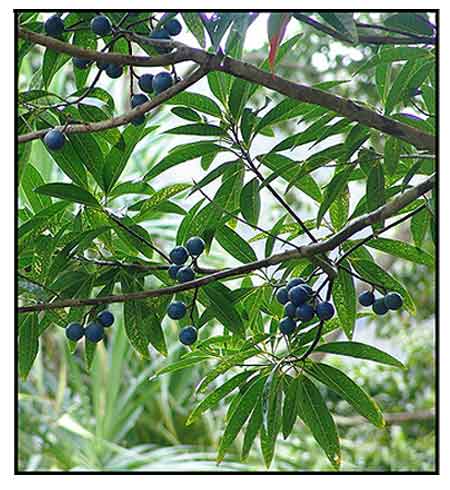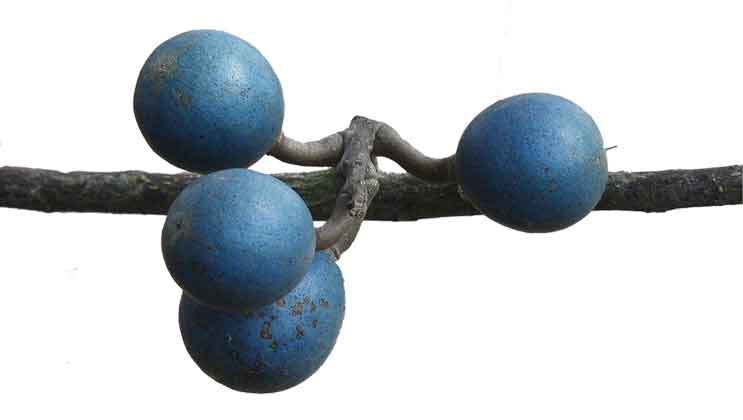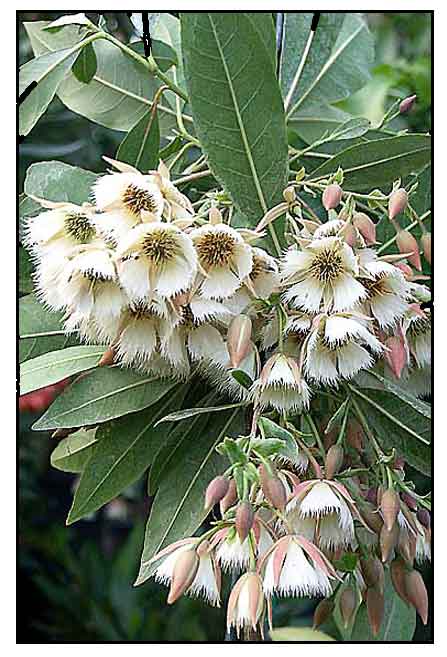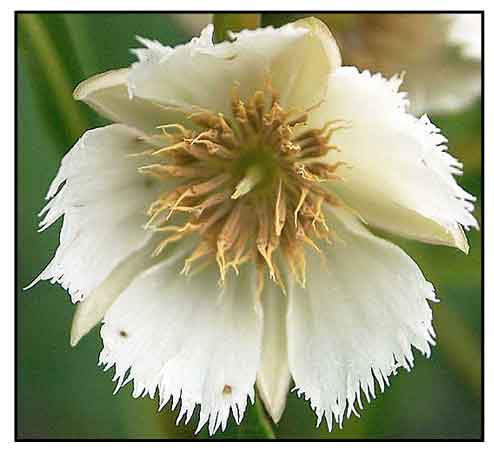 Gen info Gen info
- In India, according to Hindu religion, Rudraksha is considered a holy tree belonging to Lord Shiva.
- In Hindi mythology, Rudraksha is considered a link between heaven and earth, that it contains the secrets of evolution of the cosmos. (10)
- The Rudraksha is believed to have originated from tear drops fallen from the three eyes of Rudra (Lord Shiva), the eyes representing the sun, moon, and fire.
- Fruits of E. ganitrus are worn by Hindu mystics as necklaces in their daily worship for purpose of counting prayers and for the magical properties attributed to them. (6)
- Etymology: The genus name derives from Greek words elaia meaning "olive", and karpos meaning "fruit". The species epithet angustifolius means "narrow-leafed". (17)
Botany
Elaeocarpus angustifolius is a tree to 30 m tall, to 1.7 m d.b.h. Branches brown-gray; branchlets yellowish brown villous. Petiole 1-1.5 cm, villous, glabrescent; leaf blade obovate-oblong to oblong-lanceolate, 9-14 × 3-4.5 cm, papery or membranous, both surfaces villous when young, glabrescent when mature, lateral veins 10-13 per side, slightly prominent abaxially, impressed adaxially, base broadly cuneate, margin serrate, apex acute or obtuse. Racemes in axils of current and fallen leaves, 2-4 cm; peduncles villous. Pedicel ca. 5 mm. Sepals 5, lanceolate, ca. 5 × 1.5 mm, both surfaces villous. Petals 5, ca. as long as sepals, laciniate to 1/2 their length, lower 1/2 villous. Stamens 25; anthers setose at apices. Ovary 5-loculed, densely tomentose; style ca. 5 mm. Drupe globose, 1.7-2 cm in diam., 5-loculed. Seed 1 per locule; endocarp hard, rugulose. (Flora of China)
Elaeocarpus angustifolius is a fast-growing large tree with buttresses, able to grow up to about 30 - 40 m tall in its natural habitat. Crown is spreading, conical-shaped. Bark is light grey to brown and fissured. Leaves are dark green, obovate-oblong to oblong-lanceolate, margins serrate, measuring about 8 - 15 cm long and 2.5 - 4.5 cm wide, petiole about 1 - 1.5 cm long, old leaves become red before falling off. Flowers are white, 5-petaled, borne on an axillary raceme inflorescence about 2 - 4 cm long, petals divided at the tip into 4 or 5 lobes, stamens 25 - 50 present, ovary hairy. Fruit is a blue to purplish-blue globose fleshy drupe about 1.5 - 3 cm wide, contains 2 - 5 seeds. (17)

Distribution
- Native to the Philippines.
- Also native to Assam, Bangladesh, Bismarck Archipelago, Borneo, Cambodia, China, Hainan, Himalaya, India, Jawa, Lesser Sunda Is., Malaya, Maluku, Myanmar, Nepal, New Caledonia, New Guinea, Northern Territory, Queensland, Santa Cruz Is., Solomon Is., Sulawesi, Sumatera, Thailand, Vanuatu, Vietnam, Wallis-Futuna Is. (1)
- Grows primarily in the wet tropical biome.
- Lowland to montane forests, 100-1850 m.
 Constituents Constituents
- Phytochemical screening of ethanol extract of fruit pulp extract yielded
carbohydrates +++. reducing sugar +++, gum +, steroids +, saponin glycosides ++, flavonoids +++. tannins and phenolic compounds ++, with absence of monosaccharides, non-reducing sugar, protein, and alkaloids. (4)
- Proximate composition of pulp (%) yielded moisture 4.2, protein 4.28, fat 1.9, ash 1.55, carbohydrate 81.8 and TEV (total energetic value) 362.05 Kcal/g. (4)
-
LC-MS study of E. sphaericus seeds yielded several alkaloids with different compositions, namely: Elaeokanine C 0.90%, (+)-elaeocarpine 1.59%, elaeocarpenine 1.88%, isoelaeocarpine 1.36%, grandisine B 0.86%, isoelaeocarpiline 1.14%, grandisine D 1.51%, elaeocarpidine 1.03%, isoelaeocarpicine 1.89%, grandisine F 1.39%, grandisine A 0.89%, grandisine C 0.98%, grandisine E 1.14%, habbemine B 1.46%, habbemine A 1.24%, grandisine G 0.85%. (7)
- Study of ethanolic fruit extract of E. ganitrus showed yield extraction value of 28.65%. Preliminary phytochemical screening revealed alkaloids, glycosides, phenolic compounds, flavonoids, saponins, carbohydrates and fixed oils, with absence of protein and amino acids. Total phenolic content was 232.24 mg gallic acid equivalent (GAE) /gm. Total flavonoid concentration was 91.42 mg quercetin equivalent (QE)/g. (9)
- Study of leaves for alkaloids yielded 12 alkaloids, nine of which are new.
Seven of the nine new compounds obtained were indolizidine alkaloids: carpusinine A (5), carpusinine B (6), carpusinine C (7a), epicarpusinine C (7b), carpusinine D (8), carpusinine E (9) and carpusidine (14), while the two remaining new compounds are pyrrolidine alkaloids, namely, carpusinine F (10a) and epicarpusinine F (10b).
The three known alkaloids were identified as elaeokanine A (11), elaeokanine C (12) and
elaeokanine D (13). (12)
Properties
- Studies suggest anxiolytic, immune stimulatory, sun protective, immunomodulatory, antimicrobial, anticancer, antihypertensive, antiproliferative, contraceptive properties.
Parts used
Fruits, seeds, leaves, bark, sap.
 Uses Uses
Edibility
- Fruits are edible, raw. Thin layer of pulp around seeds of ripe fruit is edible.
Folkloric
- In the Philippines, bark used for treatment of enlarged spleen.
-
Seeds used for hypertension and heart ailments. Fruits used for epileptic fits. Leaf sap used for stomach aches, chest and shoulder pains.
- In the Indian subcontinent, used as anti-convulsant, anti-hypertensive, antimicrobial,, antidiabetic, antidepressant, analgesic.
- Used in folk medicine for treatment of stress, anxiety, depression, palpitation, nerve pain, epilepsy, migraine, lack of concentration, asthma, arthritis and liver disease. (6)
- In Ayurveda,
it is considered guru (heavy), snigdha (unctuous) in native, madhura (sweet) in taste, madhura in vipaka (sweet in post-digestive taste and sheet virya (cooling potency), attributes that has vata-pitta pacifying action on the body. (10)
- Rudraksha beads are believed to have electromagnetic properties that are beneficial to health and many bodily functions related to the heart and circulatory system. (10)
Others
- Crafts: Seeds use for making buttons, hatpins, rosary beads. (2) In India, the cleaned pits of the fruit, known as rudraksha, are widely used as prayer beads. Also used for making mala (garlands).(3)
- Wood: Soft to moderately hard; light in weight to moderately heavy; not very durable. Used for general planking, shuttering, boxes, crates, wooden pallets, oars, match splints, veneer and plywood. (2)
- Mythology / Rituals: In Hindu mythology, considered a sacred tree. The wearing of Rudraksha beads is believed to grant mental and physical prowess to achieve spiritual enlightenment. Hindu mystics wear the fruits as necklaces for purposes of prayers and magical belief. Wearing the rosary of beads around the wrist, arm, neck or head provides protection to fearlessly roam the world. (6) (10)
- Rudraksha beads / Commerce: The use of fruits and beads in Hindu rituals along with its magical attributions and many health benefits has spawned a commerce of artificial beads for which tests have been advised to check for purity and authenticity: cut test, copper coin test, water test, and electromagnetic properties. (10)
Studies
• Toxicity Studies / Seed and Leaves: An aqueous extract of E. ganitrus seed was found to be nontoxic up to a dose of 5.0 g/kbw in Swiss albino mice model. An aqueous extract of leaves did not show hemolytic activity against human erythrocytes up to 1000 µg/ml. (5)
• Anxiolytic / Fruits: Study of methanolic extract of E. sphaericus fruits at dose of 200 mg/kg increase the percentage of time-spent and percentage of arm entries in open arms of elevated plus-maze (EPM) and decrease percentage of time spent in closed arms of EPM. It also prolonged ketamine-induced latency to sleep with no significant effect on total sleeping time induced by ketamine. Locomotor activity was affected but less than that observed with diazepam. Anxiolytic effect was attributed to flavonoids. (8)
• Stimulation of Immune Mediators / Seeds: Study evaluated alkaloidal fraction of Elaeocarpus ganitrus seeds showed in vitro stimulation of immune mediators from PEC (peritoneal exudate cells)
and proliferation of immune cells. (11) .
• Sun Protective Activity /of Immune Mediators / Seeds: Study evaluated a cream formulation of ethanol extract of E. angustifolius leaves for sun protective activity in parameters of appearance, pH, spreadability, viscosity, and washability. Results suggest the leaf extract can be used as additives to improve the SPF of other sunscreen formulas. It can enhance the UV absorption qualities of
traditional sunscreen composition and increase the sunscreen capacity to block UV rays.(13)
• Anxiolytic / Quercetin / Dried Fruits: Study isolated the anxiolytic constituent of E. ganitrus using bioactive guided fractionation. Dried extracts in doses of 50, 100, 200, 400, or 800 mg/kg p.o.) were evaluated for antianxiety activity in mice. On acute toxicity testing, no mortality was reported even after 14 days up to a single dose of 5000 mg/kg. Bioassay fractionation isolated 3,3',4',5,7-pentahydroxyflavone, which at 25 mg/kg p.o. exhibited significant anxiolytic activity in mice using
EPM (elevated plus maze), light/dark chamber, and double mirrored chamber model of anxiety. (14)
• Immunomodulatory Effects / Seeds: Study evaluated a methanol extract of E. ganitrus seeds for in vitro and in vivo immunomodulatory activities. The extract showed significant stimulation of release of nitric oxide, superoxide, and lysosomal enzyme. On in vivo phagocytic activity by carbon clearance assay in mice, it showed significant increase in phagocytic index at 100 and 200 mg/kg dose. In delayed type hypersensitivity (DTH) and antibody titer assay in ovalbumin immunized mice the extract showed significant stimulation of DTH response at 200 mg/kg dose and antibody titer at 100 and 200 mg/kg dose. Results suggest the EG extract influences both non-specific (phagocytosis) and specific
(cell mediated and humoral) arms of the immune system.(15)
• OM / Morphological Studies: Om is a spiritual symbol referred to as Atman (soul) and Brahman (reality, entirety of the universe, truth, divine, supreme spirit, cosmic principles and knowledge). It is regarded as one of the most important symbols in universal religion, found in Vedas, Upanishads, and other ancient texts. It is a sacred spiritual chanting made in recitations of spiritual texts, puja, prayers, ceremonies, weddings, meditations, and yoga. The morphological study evaluated the surface of rudraksha (E. ganitrus) which indicates the presence of the universal symbol as a common site in divine beads of rudraksha. Microscopical studies observe the presence of the Om symbol on the surface of various cells of rudraksha indication the existence of Om at cellular level, further strengthening the
belief in the in the Universal presence of the symbol Om. (16)
• Weak Cholinesterase Inhibitory Activity / Alkaloids / Branches and Leaves: Study of branches and leaves of E. angustifolius isolated nine new alkaloids, (+)-1, (−)-1, 2, (+)-3, (−)-3, and 4–7, along with five known compounds (8–12). (±)-8,9-Dehydroelaeocarpine (5), (±)-9-epielaeocarpine cis-N-oxide trifluoroacetate (6), and (±)-elaeocarpine trifluoroacetate (9) exerted weak inhibitory activities against butyrylcholinesterase with IC50 values of 39, 29, and 35 μM, respectively; tacrine, the positive
control, was 0.07 ± 0.01 μM. (18)
• Silver Nanoparticles / Antimicrobial / Antiproliferative / Leaves: Study reports on the green synthesis of silver nanoparticles using leaf extract of Rudraksha . The nanoconjugates exhibited significant antibacterial activity against five clinical isolates, namely: B. cereus, E. coli, K. pneumonia P. aeruginosa, S. aureus, and antifungal activity against A. niger, A. flavus, P. notatum, and T. roseum. On MTT assay, the NPs showed potential anticancer activity with IC50 of 361.49 µg/ml against MCF-7 breast cancer cell line. Molecular docking study demonstrated favorable set of interactions for
selected cancer receptors and phytochemicals of E. sphearicus identified from GC-MS analysis. (19)
• Antihypertensive / Renal Artery Occluded Model / Seeds: Study evaluated an aqueous extract of E. ganitrus seeds powder for antihypertensive activity in renal artery occluded hypertensive rats. Elevated blood pressure was significantly decreased at dose levels of 25, 50, and 100 mg/kg, I.V. captopril, angiotensin converting enzyme inhibitor (ACE-1) at dose of 1 mg/kg IV (p<0.05). The antihypertensive activity may be due to the action on the renin-angiotensin system. (20)
• Alternative Oral Contraception / Seeds: Study evaluated the potential of ganitri seed extract as an alternative to oral contraception in female wistar rats. The seed extract at dose of 400 mg/g for 14 consecutive days increased the levels of estradiol hormone. The dose was almost close or same
as contraceptive pills in increasing the levels of estradiol hormone. (21)
Availability
- Wild-crafted.
- Seeds in the cybermarket.
|

![]()







